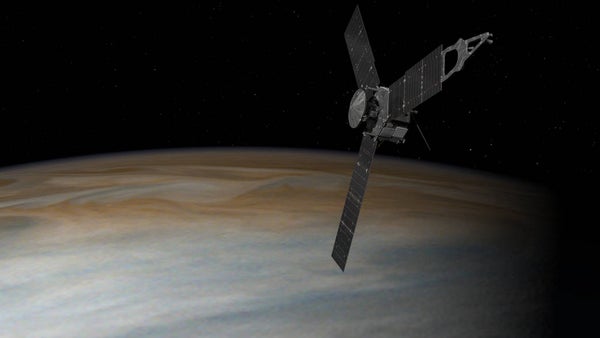PASADENA, Calif.—When ground controllers begin powering up the Juno spacecraft’s science instruments on July 6, one of their most important goals will be to get the microwave radiometer up and running. The radiometer is charged with taking water-vapor readings that will help locate Jupiter’s birthplace in the solar system and plumb its atmospheric structure, including the roots of the mysterious Great Red Spot. “This is a totally new concept specifically designed for Jupiter,” says Michael Janssen of the Jet Propulsion Laboratory, the leader of the Microwave Radiometer Team.
Water vapor is a useful tracer of Jupiter’s formation because it contains most of the oxygen present in the giant planet’s atmosphere, and theorists believe oxygen’s abundance depends on how far Jupiter formed from the sun. In the early days of our solar system the tempestuous young sun boiled oxygen and other volatile materials out of the inner system, leaving planets that formed there relatively oxygen-poor. Worlds that coalesced far from the sun, by contrast, incorporated ices laden with those materials, leaving them relatively oxygen-rich. If Juno’s microwave radiometer finds high levels of water vapor in Jupiter’s atmosphere, that would suggest the planet formed farther out from the sun than its present location. This would add to already-abundant circumstantial evidence hinting Jupiter has migrated from its place of origin.
Critically, Juno’s microwave radiometer will not simply survey Jupiter’s cloud tops—instead, it will peer below the ammonia clouds that shroud most of the planet, which are largely transparent to microwaves. What is more, because Jupiter’s microwave emissions vary in wavelength based on the pressure (as well as temperature) of the atmospheric layers where they originate, observations at multiple wavelengths allow researchers to create a cross-section through the atmosphere. Short wavelengths suss out the near-surface layers; longer wavelengths dive deeper. Juno’s radiometer will probe to a depth of about 500 kilometers. It takes a spacecraft to do that because from Earth the longer wavelengths are obscured by the thick swarms of high-energy particles trapped in the potent magnetic fields that wreathe the giant planet.
On supporting science journalism
If you're enjoying this article, consider supporting our award-winning journalism by subscribing. By purchasing a subscription you are helping to ensure the future of impactful stories about the discoveries and ideas shaping our world today.
The instrument is a kind of radio telescope consisting of six antennas of increasing size, each tuned for a specific wavelength from 1.37 centimeters to 50 centimeters. (For comparison, the microwaves in your oven or radiating from your wireless router typically have a wavelength of about 12 centimeters.) The largest antenna takes up an entire side of the hexagonal spacecraft—indeed, it sets the size of the spacecraft. It is a flat aluminum sheet with a five-by-five grid of aluminum panels, which work in harmony to measure the microwaves. Just before 3 p.m. Pacific time on Wednesday, Janssen and his team confirmed that the radiometer had woken up and detected microwaves.
The most distinctive aspect of Juno’s radiometer is its observing strategy. The spacecraft spins as it flies through space, so the instrument sweeps across the planet. It returns to the same point on the planet multiple times but with a slightly different viewing geometry each time, because the spacecraft is moving along its orbit all the while. “Every point in the atmosphere is being sampled at every angle,” Janssen says. Scientists will be able to reconstruct the atmospheric structure by taking ratios of measurements made at different angles.
Many of the most crucial parts of Juno’s studies, however, will take place back on Earth. The Very Large Array radio observatory in New Mexico will supplement Juno’s data with its own set of short-wavelength microwave observations. More importantly, a program of Earth-based lab experiments is already generating the reference data needed to interpret all of these Jovian microwave measurements. Paul Steffes at Georgia Tech and his team have built a “Jupiter in a jar”. Two half-ton steel pressure vessels simulate the Jovian atmosphere from the frigid ammonia cloud tops down to a depth of 230 kilometers, where the temperature rises to 325 degrees Celsius and the pressure to a smothering 74 times Earth’s atmosphere. Each vessel has the interior volume of a kitchen trash can and is held together by 20 giant bolts that must be tightened with correspondingly giant wrenches that exert 20 times the torque of one used on a car tire.
To measure the emission and absorption of microwaves in the pressure vessels, Steffes and his team use a deceptively simple apparatus—basically a tin can with two wires stuck in one end. It is an echo chamber for microwaves. The wires are tiny antennas—one a transmitter, the other a receiver. Through the first, the team feeds in a microwave signal. The signal reverberates through the chamber and the team measures the output through the second wire. The signal’s reverberations depend on its wavelength as well as the temperature and pressure of whatever gas fills the chamber. By trying different wavelengths and measuring how each signal propagates through the chamber’s gaseous cocktail, Steffes and his team provide critical calibrating information for Juno’s data about Jupiter’s inner depths.
As always in planetary science, the ultimate goal of studying alien worlds is to understand our own better. Not only will Juno help to reconstruct Earth's origins, it may also have more direct benefits. Steffes’s basic setup can be repurposed to study our planet’s atmosphere. Brian Drouin of JPL is currently doing just that, measuring how temperature and pressure affect the radiative properties of water vapor on Earth, which in turn influence the propagation of GPS signals. As wild as it may seem, future improvements to the accuracy of driving directions and emergency beacons could owe their existence in part to a handful of scientists who hoped to probe the murky depths of Jupiter.
